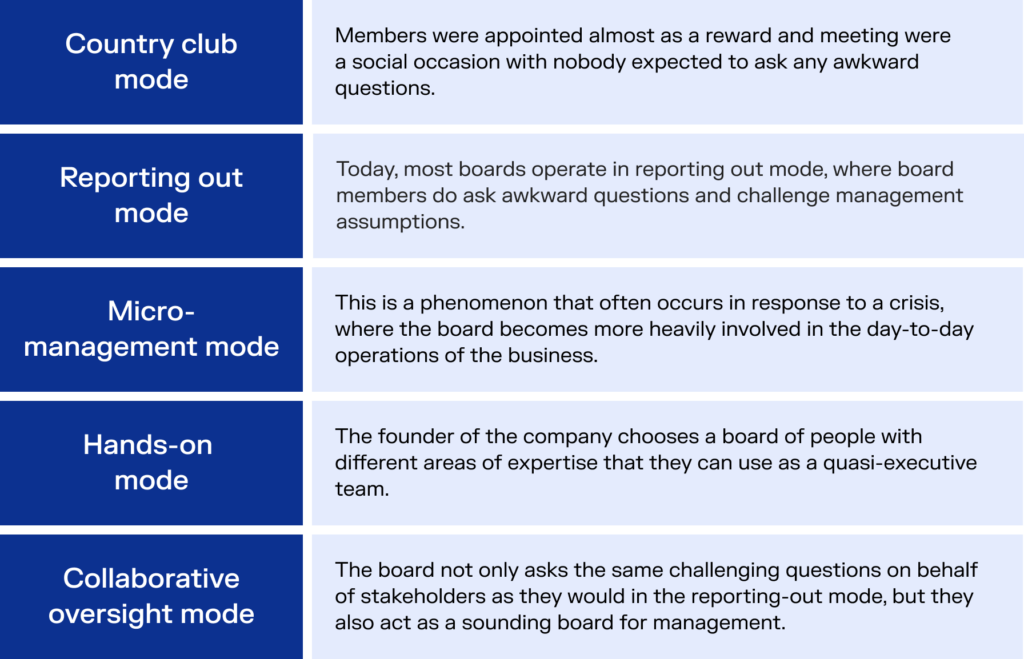The role of board directors has become increasingly crucial to the success or failure of companies in today’s business environment. Over the past two decades, their responsibilities and composition have undergone significant changes, especially in terms of diversity. Additionally, new technologies have presented them with unique challenges, requiring them to adapt and transform the way they operate.
Gone are the days of the traditional boardroom image. The modern business landscape demands a different approach, and board directors have risen to the occasion. However, the question remains: how effective are these new boardrooms?
To give our members some insights and perspectives on what has changed and how they might improve their board’s effectiveness, the M&A Community, in partnership with iDeals, hosted its first-ever community event focused specifically on board governance, board effectiveness, and board performance.Our guest speaker was Beverly Behan, global expert on board effectiveness and author of Great Companies Deserve Great Boards.
Exploring the five keyboard modes
How are boards today different from 20 years ago and what further shifts do you see in terms of how boards operate?
Probably the most significant difference we’ve seen in the past two decades is how the role of the board has changed.

Country club mode
Twenty years ago, what I call the country club mode was typical of a board anywhere in the world. Members were appointed almost as a reward and meetings were a social occasion with nobody expected to ask any awkward questions.
This all changed after the collapse of Enron, and stockholders everywhere began demanding better corporate governance. We began to see changes in the way boards operated, though that didn’t mean an end to corporate governance scandals, and maybe we still have a way to go.
Reporting out mode
Today, most boards operate in reporting out mode, where board members do ask awkward questions and challenge management assumptions.
But while the board is fulfilling its duty to shareholders in doing so, it is not tapping into the expertise at the board table as well as it might. Management can see board meetings as just an ordeal to manage and get over with so that they can get on with their plans.
Micromanagement mode
This is a phenomenon that often occurs in response to a crisis, where the board becomes more heavily involved in the day-to-day operations of the business. This may be due to an external event, such as the COVID-19 pandemic, or it may be the result of a loss of confidence or trust in management for the board.
Hands-on mode
Plenty of early-stage companies operate in a hands-on mode. The founder of the company chooses a board of people with different areas of expertise that they can use as a quasi-executive team. But while this can work really well for young start-ups, it’s a big challenge when the founder leaves and the new CEO recoils at the board making management-level decisions.
Collaborative oversight mode
Approximately 5 to 6 years ago, we noticed a shift towards a collaborative oversight model. In this approach, the board not only asks the same challenging questions on behalf of stakeholders as they would in the reporting-out mode, but they also act as a sounding board for management.
This allows the board to leverage the expertise and backgrounds of directors to provide even greater value to both stakeholders and corporate executives. We expect this trend to continue in the coming years.
I believe that we will witness an increasing number of boards embracing the collaborative oversight model. However, for this approach to succeed, there are four essential elements that must be in place:
- The CEO must foster collaboration with the board, recognizing the value of leveraging directors’ expertise instead of seeing the board as a hindrance to be appeased.
- A competent meeting facilitator is essential for the chair, willing to intervene when the board veers off-topic and engages in micromanagement.
- Board members must possess the necessary skills, expertise, and attitude to provide valuable insights and perspectives to management.
- The tone of the meetings must shift from a one-sided reporting format to a constructive dialogue between the management team and the board, engaging in meaningful discussion on significant issues.
How to build a high-performing board: The factors you need to know
I believe there are eight key factors, with the first being the most important
- Composition. Having the right people on the board is crucial, with skills, expertise, and backgrounds relevant to the company’s business and strategic direction.
- Information. Most boards are frustrated with their pre-reading materials and this is often considered also on how directors are offered orientation and opportunities to learn more about the business; this is also a fruitful area for improvement.
- Committees. How effective are the board committees and do they get the appropriate support both from executive liaisons and external advisors? Do the committee “report outs” keep non-committee members abreast of the committee’s work and decision-making?
- Leadership. How effective is the board chair? Not just when conducting the meetings but also in developing a constructive working relationship with the CEO and even in managing director performance, one of the thorniest aspects of any board leader’s role.
- Agendas. Make sure the important decisions can be made early in the meeting and that agendas are designed to focus on the most important issues and make good use of the directors’ time in the meeting.
- Dynamics. Is there mutual respect between directors? Are they comfortable sharing their views openly – and disagreeing with their peers and management? Is participation relatively well-balanced or do some directors dominate the dialogue while others say little?
- Board and Management relationship. Is the board/management relationship characterized by mutual respect, transparency, and a willingness to collaborate? Or does the board lack trust in management? Or management views the board as little more than a nuisance?
- Processes. How effectively does the board engage with management in reviewing strategy, overseeing risk, developing plans for CEO succession, conducting effective board evaluations, and the annual review of CEO performance?
Board 2.0
Having the right people is a very significant part of how effective a board can be. What are the best tools you’ve found for boards seeking to optimize their board composition?
Traditionally, people have used the Board Skills Matrix. However, this is largely an investor relations device that was developed to reassure stakeholders that directors had the kind of expertise they would want at the board table, and it can be vague with generic qualities.
A far more worthwhile board succession planning tool in my experience is Board 2.0, not only because it takes a more holistic view of board composition but also because it engages every director on this important question.
Board 2.0 was developed from my work with a company in Boston that was merging three boards into one. There were 10 seats and over 20 people were going to have to leave that board.
I interviewed everybody on the board and the senior executive to ask them what skills they each thought were essential to creating the best possible board to oversee this company. It was easy because there was so much common ground and people appreciated having the opportunity to weigh in on this question.
Even though more than 20 people left the board in the end, they all bought into the agreed composition. In fact, they recruited a new director with an IT background because they thought this was essential – and none of the current directors had this expertise.
The three stages of Board 2.0
First, you need to focus on backgrounds and expertise, asking what the best possible board would look like to govern this company in light of its business and its strategy.
Next, consider what the company wants to achieve in terms of diversity, and try to determine where good pools of diverse talent might help you achieve those goals while filling in the essential expertise/backgrounds you identified in the first step.
Finally, focus on the characteristics you’d want all of your directors to bring to the board table, such as integrity or strategic acumen. Those are things you’d explore both in interviews with director candidates and speaking to references.
Maximizing board performance through director development, evaluation and orientation
You have all the right people in place, composition-wise, and diversity-wise. Then you recruit someone who looks like a fantastic director, but they prove to be disappointing. How and should boards address director performance management in cases like this?
This is probably the biggest shortcoming in corporate governance today. In one of PwC’s surveys of 700 public company directors, 49 said that at least one of their fellow board members needed to be replaced, and one in 4 rated their board leaders as either not very or not at all effective in dealing with performance management issues.
Even the Board Chair or Lead Director tends to be viewed as first among equals, not the boss of the board, like the CEO is to the management team whom they can hire and fire at will. Directors are elected by the shareholders, are typically people with successful and accomplished backgrounds, often of very large companies, and many don’t take kindly to any hint of criticism.
Nothing undermines the credibility of a board leader more than turning a blind eye to performance management.
You can use age and term limits to ensure turnover and board refreshment, but they don’t address performance issues, such as coming unprepared to meet, hogging air time with questions that suggest a lack of understanding of the business, addressing fellow directors in a derogatory or condescending tone if they voice a different view on an issue or constantly playing gotcha with management.
Director development is a nice term that typically entails sending people on courses. But most of us know that constructive feedback is by far the best professional development tool there is.
Director evaluations are one of the best tools I’ve ever found on this front, but surveys with scores are write-ins and don’t tend to produce the kind of constructive, balanced, and actionable feedback that does this exercise really worthwhile; confidential interviews are essential, and you need to probe to get the level of feedback that directors genuinely value.
So many people think about director evaluations as a tool for dealing with underperformers, and it does work well for this purpose, but it also should be seen as a way of polishing our boardroom stars, it encourages the good people in your boardroom to be even better.
Another useful consideration for new directors is director orientation. This traditionally involves sitting down with C-suite executives and is often little more than a “drinking from a firehouse” experience for new board members.
Don’t hesitate to consider ways to learn more about the business and invite others to join in. I remember a director I was working with on an M&A project asking after the briefing if she could spend more time with the team to get up to speed on the integration, and when she asked if anyone else on the board wanted to come too, half of them said yes.
But be careful not to overdo it, you would rather not be seen as unapproachable. Every time a director asks for an additional briefing or site visit, it does require management time and effort to make this happen. But most executive teams are thrilled for a new director to exhibit so much interest in the business and a genuine commitment to learning about it, to be at their very best in the boardroom.
Why having a board buddy can benefit your board
Diversity has become increasingly important for board composition. What advice would you give to those new board members to make sure that they get off to a great start?
With an unprecedented level of diversity recruitment to boards, we have many new directors joining boards with no prior board experience. And the greatest challenge for anyone on their first board is understanding the line between governance and management.
This can be a difficult art to acquire; it’s only human nature to sit down in the boardroom and ask the same sorts of questions you might ask in your own executive team. But in doing so, you are typically asking management-level questions rather than operating at a governance/oversight level.
The best tool I’ve found to navigate this issue is having a board buddy. Not only does the buddy provide the newbie with some background on the politics and history of some board agenda items, one-to-one talks with the buddy before and after board meetings, enable the new director to compare notes on the agenda and test the questions they might want to ask.
Over time, you’ll develop a keen sense of where the line between governance and management lies, a skill that will serve you well in any boardroom. This investment of time is worth its weight in gold, far more valuable than the tired old advice of keeping your “nose in, fingers out.”

